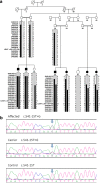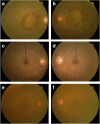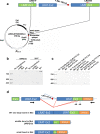A novel LRAT mutation affecting splicing in a family with early onset retinitis pigmentosa
- PMID: 29973277
- PMCID: PMC6033202
- DOI: 10.1186/s40246-018-0165-3
A novel LRAT mutation affecting splicing in a family with early onset retinitis pigmentosa
Abstract
Background and purpose: Retinitis pigmentosa is an important cause of severe visual dysfunction. This study reports a novel splicing mutation in the lecithin retinol acyltransferase (LRAT) gene associated with early onset retinitis pigmentosa and characterizes the effects of this mutation on mRNA splicing and structure.
Methods: Genome-wide linkage analysis followed by dideoxy sequencing of the linked candidate gene LRAT was performed in a consanguineous Pakistani family with autosomal recessive retinitis pigmentosa. In silico prediction and minigene assays were used to investigate the effects of the presumptive splicing mutation.
Results: ARRP in this family was linked to chromosome 4q31.21-q32.1 with a maximum LOD score of 5.40. A novel homozygous intronic mutation (NM_004744.4: c.541-15T>G) was detected in LRAT. In silico tools predicted that the AG-creating mutation would activate an intronic cryptic acceptor site, but cloning fragments of wild-type and mutant sequences of LRAT into Exontrap Cloning Vector pET01 and Expression Cloning Vector pCMV-(DYKD4K)-C showed that the primary effect of the sequence change was to weaken the nearby authentic acceptor site and cause exon skipping, with only a small fraction of transcripts utilizing the acceptor site producing the reference transcript.
Conclusions: The c.541-15T>G mutation in LRAT results in aberrant splicing and is therefore predicted to be causal for the early onset retinitis pigmentosa in this family. In addition, this work suggests that minigenes adapted to the specific gene and exon may need to be designed for variants in the first and last exon and intron to mimic the authentic splicing mechanism in vivo.
Keywords: Cryptic splice site; Exon splicing; LRAT; Linkage; Minigene assay; Retinitis pigmentosa; Splicing mutation.
Conflict of interest statement
Ethics approval and consent to participate
This study was approved by the Institutional Review Boards (IRB) of the National Centre of Excellence in Molecular Biology, Lahore, Pakistan, and the CNS IRB at the National Institutes of Health. Participating individuals or their guardians gave written informed consent to participate and to publish consistent with the tenets of the Declaration of Helsinki before the study.
Consent for publication
Not applicable.
Competing interests
The authors declare that they have no competing interests.
Publisher’s Note
Springer Nature remains neutral with regard to jurisdictional claims in published maps and institutional affiliations.
Figures






Similar articles
-
Splice-site mutations identified in PDE6A responsible for retinitis pigmentosa in consanguineous Pakistani families.Mol Vis. 2015 Aug 18;21:871-82. eCollection 2015. Mol Vis. 2015. PMID: 26321862 Free PMC article.
-
Low prevalence of lecithin retinol acyltransferase mutations in patients with Leber congenital amaurosis and autosomal recessive retinitis pigmentosa.Mol Vis. 2007 Apr 5;13:588-93. Mol Vis. 2007. PMID: 17438524 Free PMC article.
-
Homozygosity mapping and whole-genome sequencing reveals a deep intronic PROM1 mutation causing cone-rod dystrophy by pseudoexon activation.Eur J Hum Genet. 2016 Mar;24(3):459-62. doi: 10.1038/ejhg.2015.144. Epub 2015 Jul 8. Eur J Hum Genet. 2016. PMID: 26153215 Free PMC article.
-
Course of Ocular Function in PRPF31 Retinitis Pigmentosa.Semin Ophthalmol. 2016;31(1-2):49-52. doi: 10.3109/08820538.2015.1114856. Semin Ophthalmol. 2016. PMID: 26959129 Free PMC article. Review.
-
Autosomal dominant retinitis pigmentosa secondary to pre-mRNA splicing-factor gene PRPF31 (RP11): review of disease mechanism and report of a family with a novel 3-base pair insertion.Ophthalmic Genet. 2013 Dec;34(4):183-8. doi: 10.3109/13816810.2012.762932. Epub 2013 Jan 23. Ophthalmic Genet. 2013. PMID: 23343310 Review.
Cited by
-
The Role of Vitamin A in Retinal Diseases.Int J Mol Sci. 2022 Jan 18;23(3):1014. doi: 10.3390/ijms23031014. Int J Mol Sci. 2022. PMID: 35162940 Free PMC article. Review.
-
A transgenic mice model of retinopathy of cblG-type inherited disorder of one-carbon metabolism highlights epigenome-wide alterations related to cone photoreceptor cells development and retinal metabolism.Clin Epigenetics. 2023 Oct 5;15(1):158. doi: 10.1186/s13148-023-01567-w. Clin Epigenetics. 2023. PMID: 37798757 Free PMC article.
-
Toward a clinical diagnostic pipeline for SPINK1 intronic variants.Hum Genomics. 2019 Feb 12;13(1):8. doi: 10.1186/s40246-019-0193-7. Hum Genomics. 2019. PMID: 30755276 Free PMC article.
-
Retinoid dynamics in vision: from visual cycle biology to retina disease treatments.Pharmacol Ther. 2025 Sep;273:108902. doi: 10.1016/j.pharmthera.2025.108902. Epub 2025 Jun 21. Pharmacol Ther. 2025. PMID: 40550364 Free PMC article. Review.
-
Detecting and Validating MAPT Mutations in Neurodegeneration Patients and Analysis of Exon Splicing Consequences.Methods Mol Biol. 2024;2754:411-433. doi: 10.1007/978-1-0716-3629-9_22. Methods Mol Biol. 2024. PMID: 38512679
References
-
- Bird AC. Retinal photoreceptor dystrophies LI. Edward Jackson memorial lecture. AmJOphthalmol. 1995;119:543–562. - PubMed
-
- Bunker CH, Berson EL, Bromley WC, Hayes RP, Roderick TH. Prevalence of retinitis pigmentosa in Maine. AmJOphthalmol. 1984;97:357–365. - PubMed
-
- Rivolta C, Sharon D, DeAngelis MM, Dryja TP. Retinitis pigmentosa and allied diseases: numerous diseases, genes, and inheritance patterns. HumMolGenet. 2002;11:1219–1227. - PubMed
Publication types
MeSH terms
Substances
Grants and funding
LinkOut - more resources
Full Text Sources
Other Literature Sources

